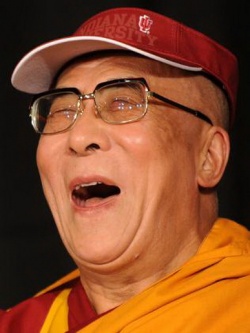Discovery as Dalai Lama
When Lhamo Thondup was two years old, a search party that had been sent out by the Tibetan government to find the new incarnation of the Dalai Lama arrived at Kumbum monastery. It had been led there by a number of signs. One of these concerned the embalmed body of his predecessor, Thupten Gyatso, the Thirteenth Dalai Lama, who had died aged fifty-seven in 1933. During its period of sitting in state, the head was discovered to have turned from facing south to northeast. Shortly
after that the Regent, himself a senior lama, had a vision. Looking into the waters of the sacred lake, Lhamoi Lhatso, in southern Tibet, he clearly saw the Tibetan letters Ah, Ka and Ma float into view. These were followed by the image of a three-storied monastery with a turquoise and gold roof and a path running from it to a hill. Finally, he saw a small house with strangely shaped guttering. He was sure that the letter Ah referred to Amdo, the northeastern province, so it was there that the search party was sent.
By the time they reached Kumbum, the members of the search party felt that they were on the right track. It seemed likely that if the letter Ah referred to Amdo, then Ka must indicate the monastery at Kumbum, which was indeed three-storied and turquoise-roofed. They now only needed to locate a hill and a house with peculiar guttering. So they began to search the neighboring
villages. When they saw the gnarled branches of juniper wood on the roof of the His Holiness' parent's house, they were certain that the new Dalai Lama would not be far away. Nevertheless, rather than reveal the purpose of their visit, the group asked only to stay the night. The leader of the party, Kewtsang Rinpoche, then disguised himself as a servant and spent much of the evening observing and playing with the youngest child in the house.
The child recognized him and called out “Sera lama, Sera lama”. Sera was Kewtsang Rinpoche's monastery. The next day they left only to return a few days later as a formal deputation. This time they brought with them a number of possessions that had belonged to the Thirteenth Dalai Lama, together with several similar items that did not belong to the Thirteenth Dalai Lama. In
every case, the infant correctly identified those belonging to the Thirteenth Dalai Lama saying, “It's mine. It's mine”. This more or less convinced the search party that they had found the new incarnation. It was not long before the boy from Taktser was recognized to be the new Dalai Lama.
The boy Lhamo Thondup was first taken to Kumbum monastery. “There now began a somewhat unhappy period of my life”, His Holiness was to write later, reflecting on his separation from his parents and the unfamiliar surroundings. However, there
were two consolations to life at the monastery. First, His Holiness' immediate elder brother Lobsang Samden was already there. The second consolation was the fact that his teacher was a very kind old monk, who often seated his young disciple inside his gown.
Lhamo Thondup was eventually to be reunited with his parents and together they were to journey to Lhasa. This did not come about for some eighteen months, however, because Ma Bufeng, the local Chinese Muslim warlord, refused to let the boy-incarnate be taken to Lhasa without payment of a large ransom. It was not until the summer of 1939 that he left for the capital,
Lhasa, in a large party consisting of his parents, his brother Lobsang Samden, members of the search party, and other pilgrims.
The journey to Lhasa took three months. “I remember very little detail apart from a great sense of wonder at everything I saw: the vast herds of drong (wild yaks) grazing across the plains, the smaller groups of kyang (wild asses) and occasionally a herd of gowa and nawa, small deer which were so light and fast they might have been ghosts. I also loved the huge flocks of hooting geese we saw from time to time”.
Lhamo Thondup's party was received by a group of senior government officials and escorted to Doeguthang plain, two miles outside the gates of the capital. The next day, a ceremony was held in which Lhamo Thondup was conferred the spiritual
leadership of his people. Following this, he was taken off with Lobsang Samden to the Norbulingka, the summer palace of His Holiness, which lay just to the west of Lhasa.
During the winter of 1940, Lhamo Thondup was taken to the Potala Palace, where he was officially installed as the spiritual leader of Tibet. Soon after, the newly recognized Dalai Lama was taken to the Jokhang temple where he was inducted as a novice monk in a ceremony known as taphue, meaning cutting of the hair. “From now on, I was to be shaven-headed and
attired in maroon monk's robes”. In accordance with ancient custom, His Holiness forfeited his name Lhamo Thondup and assumed his new name, Jamphel Ngawang Lobsang Yeshe Tenzin Gyatso.
His Holiness then began to receive his primary education. The curriculum consisted of five major and five minor subjects. The major subjects were logic, Tibetan art and culture, Sanskrit, medicine, and [[Buddhist
philosophy]] which was further divided into a further five categories: Prajnaparimita, the perfection of wisdom; Madhyamika, the philosophy of the middle Way; Vinaya, the canon of monastic discipline; Abidharma, metaphysics; and Pramana, logic and epistemology. The five minor subjects were poetry, music and drama, astrology, composition and phrasing, and synonyms.
